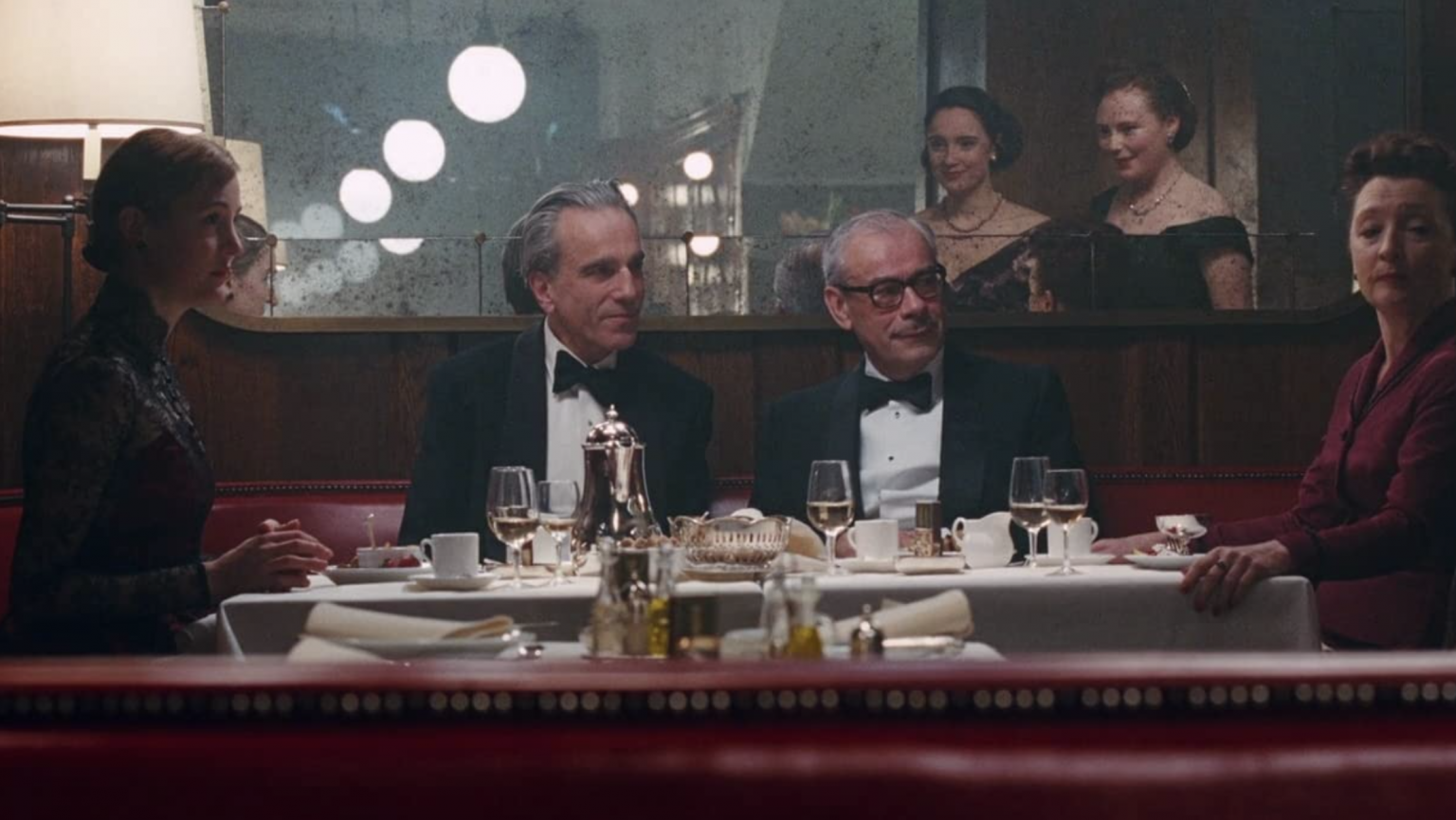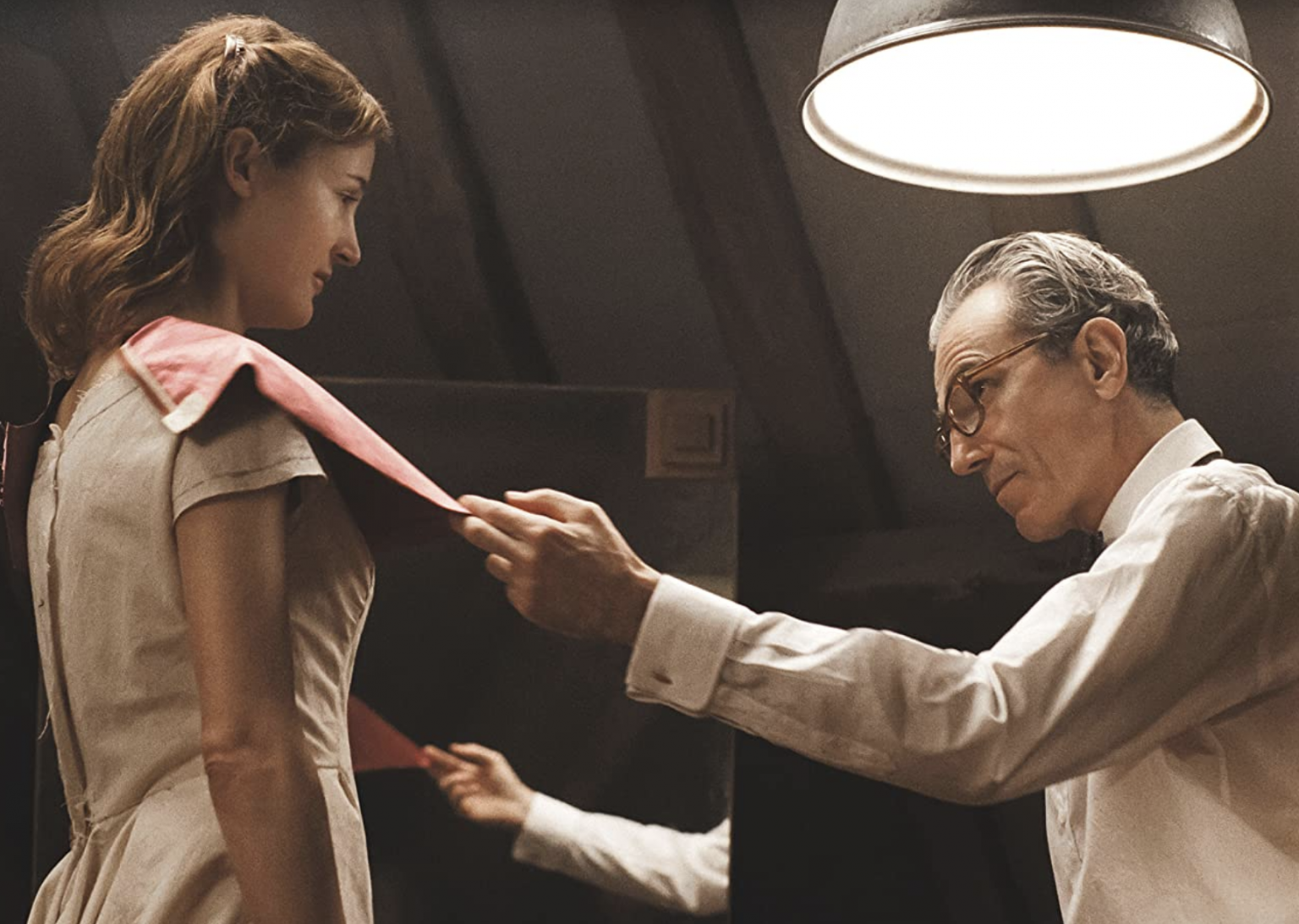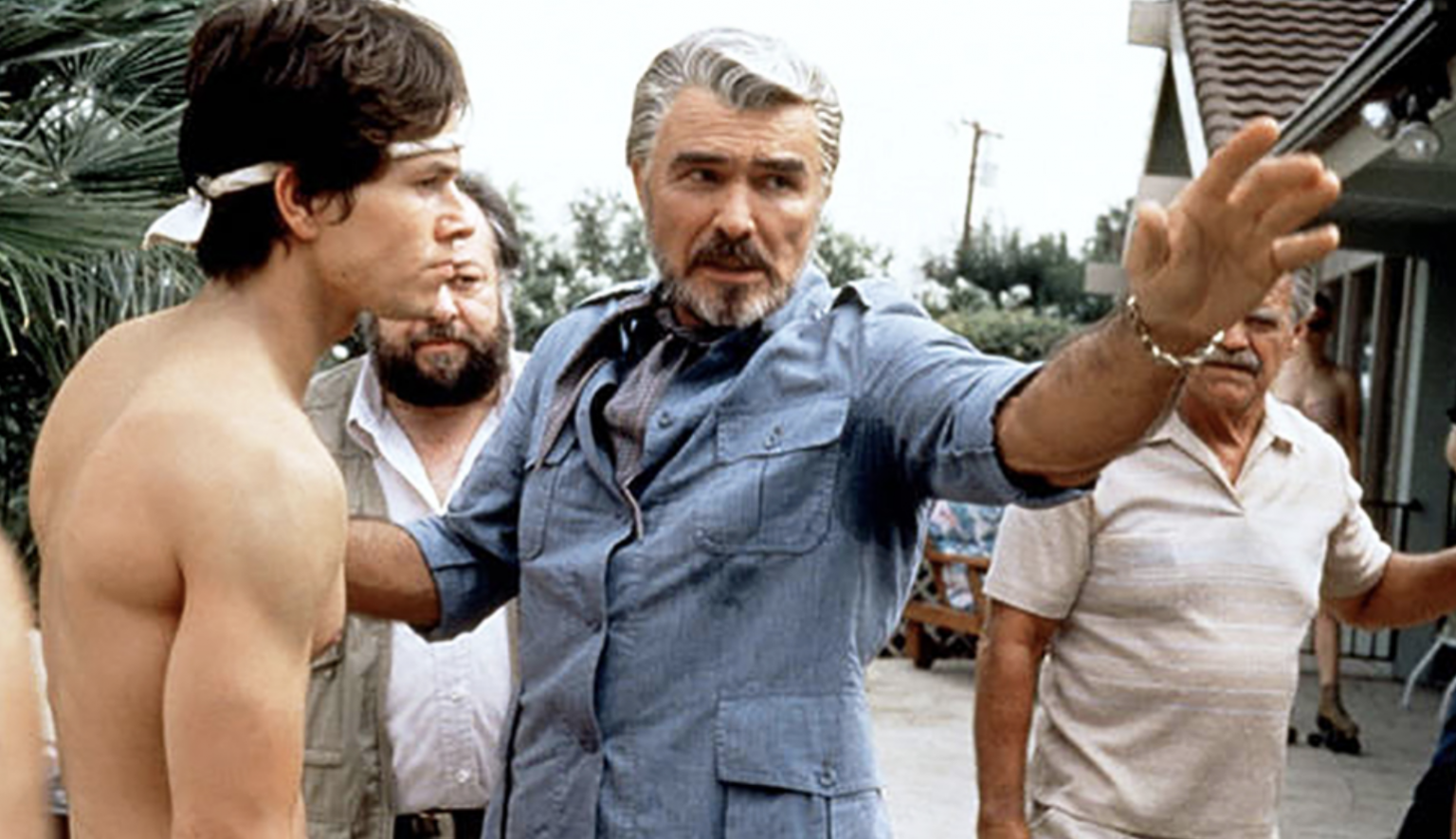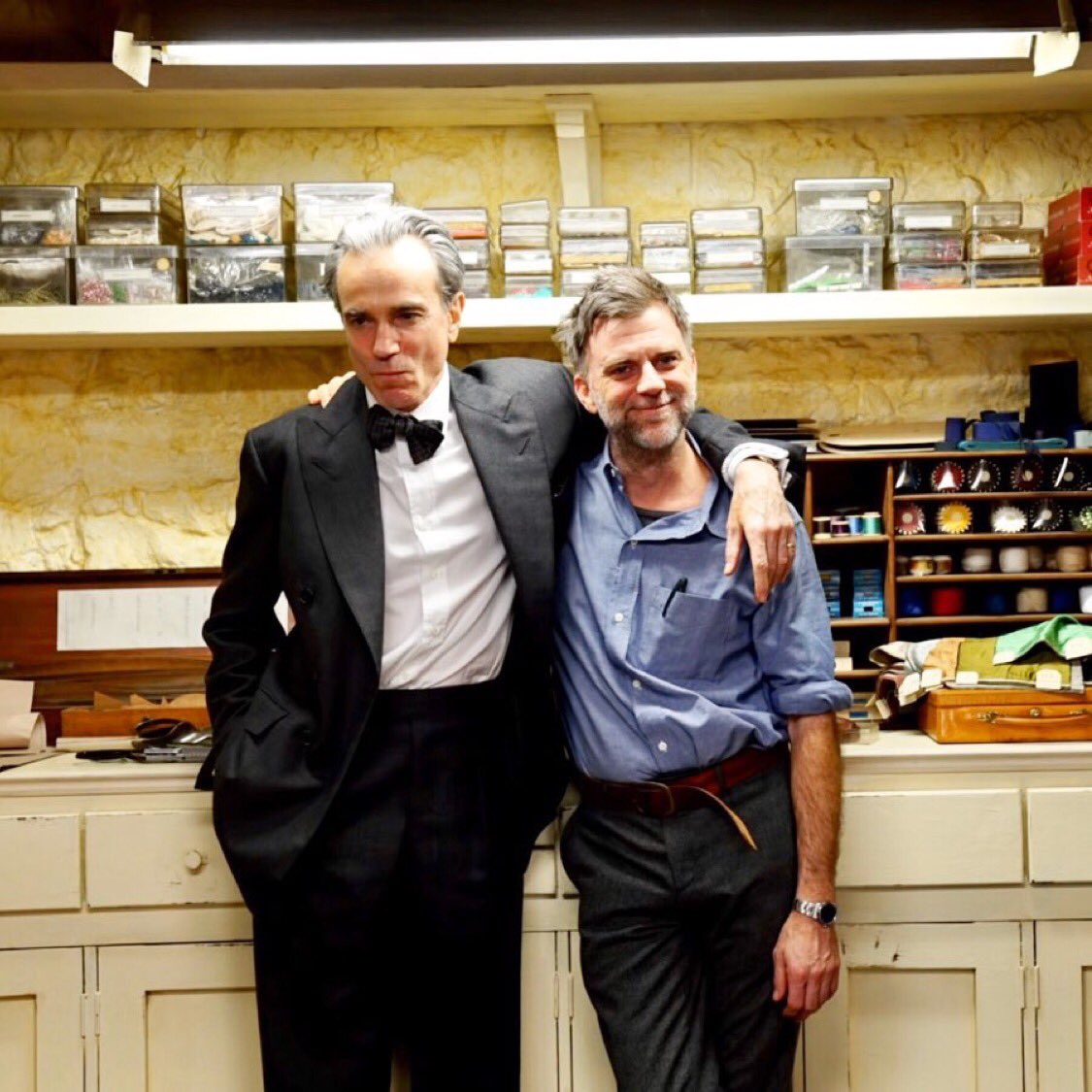
Film
Words by Tim Piccione
Anecdotes By Paul Thomas Anderson
Images Courtesy Of IMDB
If people write what they know, then director/writer Paul Thomas Anderson must deeply understand the psyche of fragile, damaged, and emotionally repressed men.
Set in 1955 London, Phantom Thread takes place in the confined setting of an haute-couture fashion house under the thumb of celebrated designer Reynolds Woodcock (Daniel Day-Lewis). After meeting a young waitress (Vicky Krieps) in the countryside and bringing her home as his lover and muse, Reynolds’ personal and professional lives begin to change. Like most Anderson films, Phantom Thread falls awkwardly between genres. It’s perhaps most aptly categorised in the “adopted romance genre”–a phrase the auteur used to define some of the older films he watched in preparation.
The film depicts its central relationship as a relentless power struggle, one primarily dictated and steered by the choices and needs of the older, more affluent Reynolds. A self-proclaimed bachelor, who chooses partners at his discretion before discarding them when “bored”. But Alma’s desperation to remain in her adopted life leads to poisoning the man slipping away from her, weakening him into a pile of needy sickness.
This objectively egregious yet justified (at least, in the film’s bizarre context) act was the original idea and starting point of the story. “I remember that I was very sick, just with the flu, and I looked up, and my wife (Maya Rudolph) looked at me with a tenderness that made me think, ‘I wonder if she wants to keep me this way, maybe for a week or two’,” Anderson said in a 2018 Collider interview. The kind of romantic mistrust and suspicious thinking that would make Alfred Hitchcock proud.
A character study of a man drunk on his own talent and reputation, Reynolds surrounds himself with voiceless women (other than maybe his rock and emotionless “old so-and-so” played by Leslie Manville) but also craves companionship on his own terms. He justifies his behaviour as a means to support and further his gift to the world of fashion. In a 2018 Academy Conversations interview, Anderson roughly explained the premise as “a man of great fussiness, singular, self-obsessed and possessed and what would happen when his life was interrupted by love.”


We meet the acclaimed designer in the film’s opening sequence during an elegant morning routine. I’ve inducted this into the ‘getting ready for work montage’ hall of fame alongside other bona fide narcissists like American Psycho’s Patrick Bateman or The Wolf of Wall Street’s Jordan Belfort. It’s here we’re introduced to the perfectionism and particularities that define him as a person, a professional and a romantic partner. Like so many of Daniel Day-Lewis’ scenes in his final performance, watching Reynolds prepare for a day in the revered House of Woodcock is disturbingly comforting. Under Radiohead guitarist and long-time PTA collaborator Jonny Greenwood’s calming and melodic piano score, the procedure is precise and practised–setting the tone for the day to come.
Alma opens the film sitting fireside, calmly answering for her continued involvement in the relationship. “He’s a very demanding man, isn’t he? Must be quite a challenge to be with him,” asks (or rather, states) a young doctor visiting the House of Woodcock. “Yes,” she responds. “Maybe he is the most demanding man.”
Forget the emotionally ‘demanding’, all-encompassing requests of love, sex and affection written into deeply fantastical male protagonists like Twilight’s Edward Cullen or Fifty Shades of Grey’s Christian Grey. Instead, imagine the kind of manipulative male behaviour normalised as reflecting common attitudes in films of the 1940s and 1950s. Behaviours we’d today refer to as toxic masculinity.
The couple’s first date winds up in a country estate attic with a vulnerable but willing Alma standing undressed as a living mannequin. She does so for the critical eye and measuring tape of a creatively stirred Reynolds who establishes a power dynamic. “I like to see who I’m talking to,” he tells her earlier in the night while removing her lipstick. Amidst a genuine and, at times, passionate romance, this is later followed by several red-flag instances of a petulant child inside an egotistical man–one set in his ways and prone to temper tantrums. Like storming out of breakfast in response to the intrusive sounds of toast scraping and tea pouring. “Please don’t move so much, Alma,” he says. Or, as an attempted surprise dinner turns into a perceived ambush with Alma preparing asparagus with butter instead of oil and salt. “Right now, I’m just admiring my own gallantry for eating it the way you’ve prepared it,” he says, effortlessly bullying her. Through Alma, we lie in perpetual fear of disturbing his particularities and sensibilities, even minorly.


Reynold’s absolute dedication to his work drives the story’s claustrophobic nature–primarily confined to the House of Woodcock’s interior. This puts the relationship’s battleground on his soil and under his control. In Paul Thomas Anderson: Masterworks, Adam Nayman notes: “there is a smell of death about this house,’ Reynold’s admits late in the film, missing that the source of the stench is his own unforgiving perfectionism, his need to have things just so.”
Is showcasing this behaviour, as suggested by The New Yorker’s Aleksander Hemon in a 2018 article, propaganda for the patriarchy and toxic masculinity? Or is Anderson, described by Nayman as a “conscientious and encyclopaedic cinephile who wears his inspirations proudly and flamboyantly on his sleeve,” showcasing the deeply flawed men who once owned the genre.
In a 2018 interview with Film Inquiry, Anderson labelled himself an aficionado of the adopted romance genre, watching films like Alfred Hitchcock’s Rebecca (1940) and Suspicion (1941) as well as Thorold Dickinson’s Gaslight (1944) in preparation for Phantom Thread. To varying degrees, these films feature prominent, domineering, but ostensibly ‘charming’ male protagonists. An irresponsible gambling addict suspected of plotting to murder his new wife, a mysterious widower suspected of having murdered his first wife, and an emotionally manipulative husband whose behaviour was so dangerously toxic, it created the term gaslighting. In some ways, Reynolds draws inspiration from these romantic partners–from their outwardly affable and magnetic personalities to the power imbalance each creates between themselves and their younger, often vulnerable partners.
A lot has been written about the matching intensity, and passion for work Anderson shares with Reynolds. But according to him, that’s where the similarities stop. “It’s similar in how seriously we take the work, but not at all similar in how seriously we take ourselves,” the director told Collider. Watching an interview with Anderson confirms he’s not a self-serious person.
“There’s no separation, for me. I don’t have any hobbies, besides doing this. This is what I do. This is my life.”
Indeed, Anderson took the auteur label to the next level on this production, acting as its director and (although uncredited) its cinematographer. Looking at the rest of his filmography, it’s clear that the writer/director (whether intentionally or not) has an affinity for exploring the depths of flawed, egotistical, and dangerously uncompromising male characters. Ones often steeped in self-hatred or self-aggrandising.
Consider the self-sabotaging, ego-driven fall from grace of Mark Wahlberg’s Eddie Adams (aka Dirk Diggler) in 1997’s Boogie Nights. The ruthless pursuit of absolute power by oil prospector and brutal capitalist Daniel Plainview (Daniel Day-Lewis) in 2007’s There Will Be Blood. Lancaster Dodd’s (Phillip Seymour Hoffman) manipulation of people through fear and fantasy, and Freddie Quell’s (Joaquin Phoenix) attempted control of self through emotional repression and alcohol abuse in 2012’s The Master. Or Barry Egan (Adam Sandler), the lonely, socially awkward small business owner with a lack of confidence and a severe anger problem desperate for controlled happiness in 2002’s Punch-Drunk Love. Hard Eight’s John (John C. Reilly), the down-on-his-luck, rash decision-maker or his mentor Sydney (Phillip Baker Hall), desperately covering up his own past. Or Josh Brolin’s Bigfoot, a dangerous cop cheerfully prone to ‘civil rights violations’ and power trips in 2014’s Inherent Vice. And finally, the literal representation of unapologetic, toxic masculinity–Tom Cruise’s Frank T.J. Mackey, who teaches scared, desperate male followers to control the opposite sex as he represses emotional trauma in 1999’s Magnolia.



Alongside Reynolds Woodcock, this collection of fictional men have one thing in common: the desire or need to control. Which is usually obtained through the abuse of themselves and/or others. And with little to no information on Anderson’s upcoming release, Soggy Bottom, we can likely expect a continuation of this flawed male trend with Bradley Cooper’s character (an educated guess) in the 1970s drama set in LA’s San Fernando Valley.
However complicated Anderson’s Phantom Thread feels, uncomfortably illustrating the dangers of the male ego, both past and present, it remains one of the most impressive films of the past decade. From a director who, at 26, premiered a raw and personal neo-noir at Sundance as his first feature film. Notably, for me, the age I am as I write this.
Phantom Thread may not be the filmmaker’s most celebrated film (see There Will Be Blood), his most universally beloved film (see Boogie Nights), or even his personal favourite (see The Master)–but it is a perfect continuation and evolution of the Paul Thomas Anderson filmography. Someone whose films can be unnerving and beautiful, comical and challenging, overwhelming and joyful, but altogether disconcerting in a most fantastic way.
A fan of Horror Movies, Paul Thomas Anderson, The Washington Wizards, Plot Twists, Lakeith Stanfield & Pastrami Sandwiches